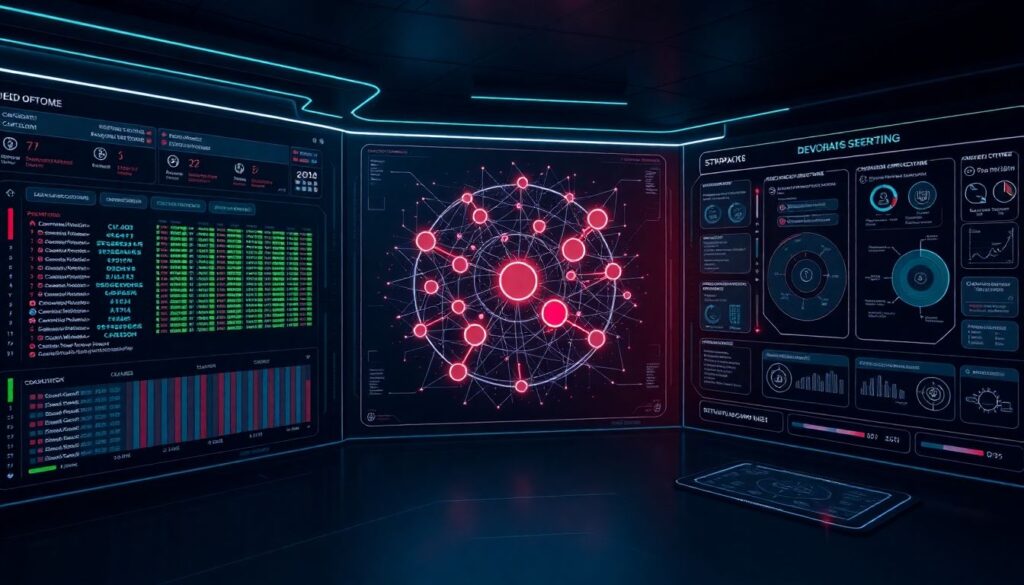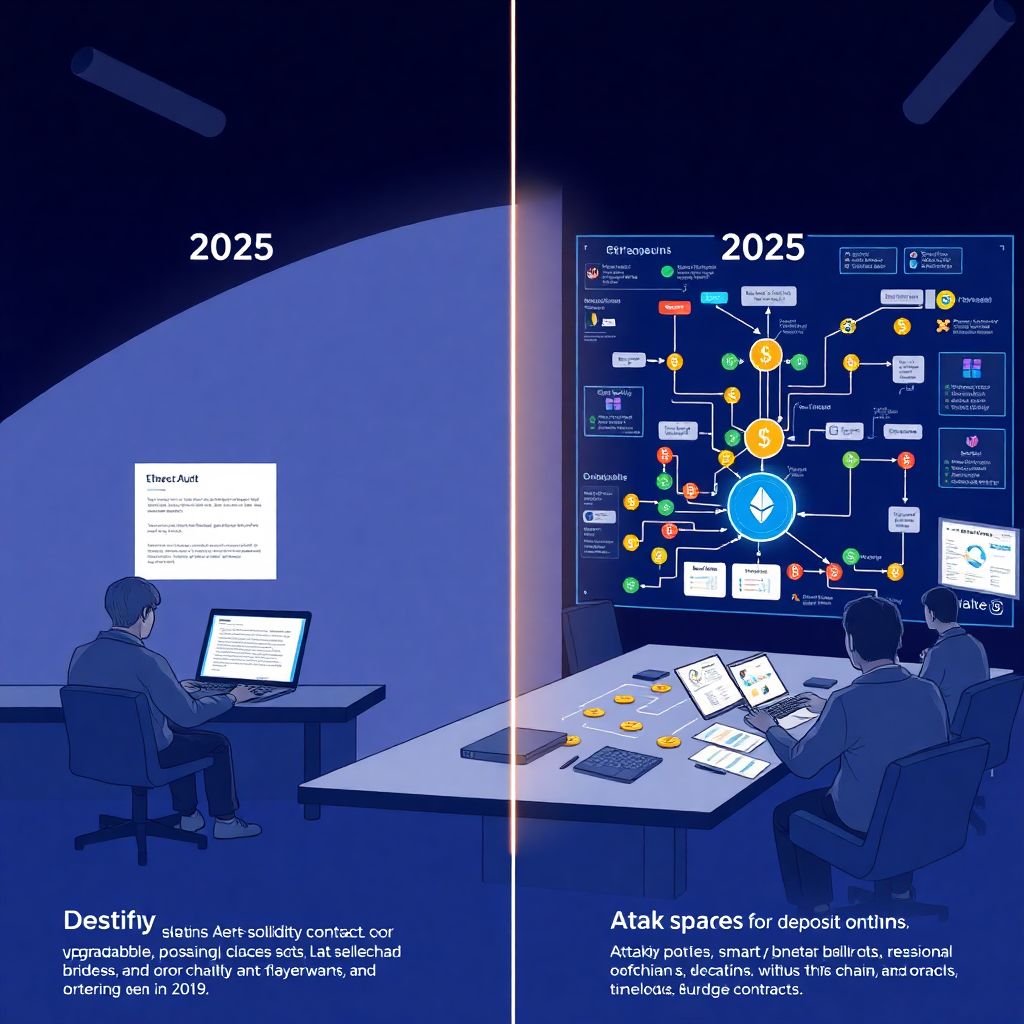“`html
Why DeFi protocol audits in 2025 feel very different from 2019

“`
Back in 2019, you could review a 500-line Solidity contract over a weekend and call it a day. In 2025, a “simple” DeFi protocol is often a mesh of upgradeable proxies, cross-chain bridges, oracle integrations, L2 message buses and a governance system connecting it all.
So if you’re a researcher trying to build a practical approach to DeFi protocol audits, you need a process that is repeatable, time‑boxed, and realistic — not a heroic all‑nighter with Etherscan and a hunch.
Below is a field-tested way to structure your work, with concrete examples, technical checkpoints, and a short forecast of where DeFi audits are heading over the next 3–5 years.
—
“`html
Step 1. Define the “attack surface” before reading a single line of code
“`
The biggest mistake I see researchers make: they jump into the main Solidity repo and ignore everything else. In DeFi, most critical bugs live in integration points, not in the core AMM math.
Think of the attack surface as every place where untrusted input meets critical state:
1. Smart contracts (on all chains)
2. Off-chain components (keepers, bots, relayers)
3. Oracles and price feeds
4. Governance (including tokenomics and incentives)
5. Admin keys, multisigs, upgrade mechanisms
6. Bridges and cross-chain message layers
What this looks like in practice
Imagine you’re reviewing a new lending market that claims to be “Aave but gas-optimized.” TVL goal: $100M in 6 months. Deployed on Ethereum mainnet and Arbitrum, with a custom price oracle.
Before touching code, you want two diagrams from the team:
– High-level architecture (boxes and arrows)
– Data flow for at least:
– Deposit
– Borrow
– Liquidation
– Cross-chain rebalance (if any)
If a team can’t give you this in a readable form within a day, that’s already a risk signal.
> Technical focus block – Minimal attack surface checklist
> For each protocol, enumerate:
> – All contracts + addresses + chains
> – All roles (EOA, multisig, DAO, guardians) and their permissions
> – All external dependencies (oracles, bridges, external DeFi protocols)
> – All ways protocol state can change without a direct user transaction
> – All upgrade paths (proxy admin, timelocks, on-chain governance)
This initial map will guide where to go deep and where to only do a light pass.
—
“`html
Step 2. Build a threat model that is actually quantitative
“`
A lot of audits stop at “we looked for reentrancy, overflow and logic bugs.” That’s not a threat model; that’s a shopping list.
Instead, you want to reason about who might attack and why, with numbers.
Start from economic incentives
In 2025, a well-designed protocol can be exploited with a single clever route through a DEX aggregator plus a flash loan. The practical rule of thumb:
– If the expected one-shot payoff is > $500k
– And the attack complexity is manageable for a senior Solidity dev
– Then assume someone will find it within 3–6 months of mainnet launch
You can approximate expected payoff by looking at:
– Target TVL on each chain
– Max value in a single pool / market
– Liquidation penalties and fees (for oracle/gov manipulation scenarios)
Combine that with current bug bounty size. If your bug bounty is $200k and the exploit potential is $5M, that’s a 25x mismatch. Historically, this is when black‑hat behavior wins.
> Technical focus block – Quick incentive model
> 1. Estimate max extractable value (MEV, but at protocol level, not block level):
> – TVL × realistic drainable percentage (often 30–70% for lending)
> 2. Compare to:
> – Bug bounty cap
> – Cost of attack capital (flash loans, collateral, bribes)
> 3. Assign “economic pressure score”:
> – Low: payoff < $250k
> – Medium: $250k–$2M
> – High: > $2M
This quantitative threat modeling is exactly what defi protocol security audit teams at major firms now use to prioritize their manual review time.
—
“`html
Step 3. Triage components instead of “auditing everything equally”
“`
Not all modules deserve the same amount of scrutiny. For a resource-constrained researcher, this is where you win or lose.
A reasonable triage strategy:
1. Critical path logic
Anything that moves real value or controls who can move it:
– Core AMM / lending / staking logic
– Accounting (shares, indexes, interest rates)
– Liquidation logic
– Bridge message handlers
2. Privileged control and upgrades
– Proxy admins, timelocks, governor contracts
– Emergency shutdown / pause logic
– Access control libraries
3. Integrations and adapters
– Oracles (including any custom TWAP/median logic)
– External protocol wrappers (Aave, Lido, Curve, etc.)
– Cross-chain communication
4. Low-risk / peripheral
– View-only helpers
– Pure math libraries (if reviewed / widely used)
– Front-end-only utilities
You give tiers 1 and 2 the bulk of your manual review time and fuzzing. Tier 4 might only get a fast static sweep.
> Technical focus block – Practical triage signals
> – Lines of code interacting with `transfer`, `call`, `delegatecall`
> – Any `assembly` blocks
> – Any contract that can:
> – change protocol-wide params
> – move tokens out of the protocol
> – upgrade implementations
This is roughly how experienced smart contract auditing companies allocate their staff: senior reviewers focus on tiers 1–2, juniors learn on 3–4.
—
“`html
Step 4. Blend manual review, property testing and fuzzing
“`
In 2025, nobody serious relies on a single technique. The most practical approach combines:
– Manual spec vs implementation review
– Invariant/property testing
– Differential testing (if a similar protocol exists)
– Fuzzing driven by stateful invariants
Manual review: reading code against a mental spec
The key trick: write down the intended behavior first — short, plain-English rules. For example, for a lending protocol:
1. Total deposits – total borrows = system equity ≥ 0
2. A user’s health factor must not fall below 1.0 after any allowed action
3. Liquidators must lose money if they try to liquidate a healthy position
Then you review the code only to answer: “Is this always true?” Not “is the code pretty?”
Property tests and invariants
Once your invariants are clear, property tests become straightforward. You can use Foundry or Echidna-style tools to encode them.
> Technical focus block – Example invariant (Foundry-style)
> “`solidity
> function invariant_totalReservesNonNegative() public {
> uint256 totalDeposits = lending.totalDeposits();
> uint256 totalBorrows = lending.totalBorrows();
> assertGe(totalDeposits, totalBorrows);
> }
> “`
> Extend invariants across:
> – liquidations
> – interest rate changes
> – multi-user interactions
Fuzzing is only as good as your invariants; without them, you’re just throwing random values at a wall.
—
“`html
Step 5. Don’t neglect governance, admin keys and “off-chain glue”
“`
Many DeFi protocols still get “audited” on-chain while leaving the most dangerous parts off-chain:
– Governance voting logic in scripts
– Relayers for cross-chain upgrades
– Crons/keepers managing rebalancing, liquidations or reward streams
Every credible blockchain security audit firm now explicitly includes governance and operations in their scope. As an independent researcher, you should too.
Concrete example from practice
In 2023–2024 there were several incidents (and near-misses) where:
– Timelock delay was configurable by a multisig
– That multisig could be upgraded or reconfigured without delay
– Result: one compromised signer meant instant protocol takeover
The Solidity contracts “looked safe,” but the actual upgrade path was a house of cards.
> Technical focus block – Governance review checklist
> – Who can:
> – change critical params (LTVs, oracles, fees)?
> – upgrade implementations?
> – pause / unpause the protocol?
> – Are changes time-locked? For how long? (Common ranges: 24h–7d)
> – Is there an emergency brake with shorter delay? Who controls it?
> – Are there on-chain constraints on parameter ranges (e.g. max LTV)?
If you ever consider whether to hire defi security auditor or do it in-house, this governance/ops part is where external people often spot blind spots the team is too used to.
—
“`html
Step 6. Communicate issues like an engineer, not a lawyer
“`
A practical DeFi audit is only as valuable as its report. Researchers often underinvest in clarity.
Aim for:
– Reproduction steps
– Concrete exploit scenarios
– Realistic impact estimates
– Suggested patches or design alternatives
A good issue write-up tells a story: “A sophisticated attacker could use X, Y, Z to drain up to N% of pool A, assuming current parameters, in one transaction.”
> Technical focus block – Minimal issue template
> – Title: Short, descriptive
> – Severity: Informational / Low / Medium / High / Critical
> – Context: Contract + function + scenario
> – Description: What goes wrong and why
> – Proof of concept: Test, script, or tx-level outline
> – Impact: Max loss, affected users, preconditions
> – Recommendation: Patch or mitigation strategy
It’s not a coincidence that the most impactful defi smart contract audit services in the market have standardized templates like this; they help maintainers actually fix things.
—
“`html
Common failure patterns in DeFi audits (with real-world flavor)
“`
A few patterns keep repeating:
1. Mis-specified oracles
Protocols implement custom TWAP or median oracles to be “more robust,” but:
– Forget to cap price changes per block
– Don’t handle zero-liquidity or low-liquidity pools
– Allow governance to switch oracle sources without delay
This has contributed to multiple nine-figure losses industry-wide, often via classic price-manipulation lending exploits.
2. Over-trusting integrations
Wrapping another protocol doesn’t mean you inherit its safety.
Adapters that assume “this function will never revert” or “this token has 18 decimals” are common sources of grief.
3. Governance that can silently brick or drain the system
If a single proposal can both upgrade the implementation and change a critical param with minimal delay, you have a time bomb.
As a researcher, make a habit of explicitly simulating “malicious governance” in your mental model.
—
“`html
How individual researchers fit into a professional audit ecosystem
“`
By 2025, institutional teams routinely work with 2–3 different audit providers plus an internal review. Many combine:
– A large smart contract auditing company for structured review
– A smaller boutique or independent experts for specialized economic analysis
– Open bug bounties and competitive audit contests
This is where solo and academic researchers shine: you don’t need to compete with full-service audit shops; you can focus on:
– Novel attack patterns (e.g. new cross-chain or L2-specific quirks)
– Formal reasoning about incentive structures
– Deep dives into one subsystem (governance, bridges, oracle design)
And then either publish public research or contract with teams that value independent review.
—
“`html
Forecast: where DeFi protocol audits are heading after 2025

“`
A few trends are already visible and will shape your work as a researcher.
1. From “point-in-time audit” to continuous assurance

Static, one-off audits are being replaced by:
– CI-integrated security checks on every commit
– On-chain monitors tracking invariants in production
– Automatic simulation of governance proposals before execution
Expect “audit dates” to become less important than ongoing risk scores and dashboards.
2. Tooling will commoditize simple bugs
Reentrancy, missing `checks-effects-interactions`, basic overflow, and naive access control are already mostly caught by modern frameworks. Over the next 3 years, expect:
– Stronger symbolic execution tools integrated into IDEs
– More domain-specific fuzzers with DeFi primitives baked in
– Auto-detection of common misconfigurations (like unbounded slippage)
Your edge as a researcher will be in systemic reasoning, not finding the 101-level bug.
3. Economic and cross-domain analysis becomes standard
The hardest exploits today involve:
– Multi-protocol routing (DEXes, lending, CDPs, perpetuals)
– Cross-chain state desync
– Oracle/MEV interplay
We’re moving toward a world where defi protocol security audit means modeling the protocol as a game with incentives, not just as code with branches. Expect more:
– Agent-based simulations
– Formal economic models of liquidation cascades
– Stress testing under adversarial order flow
4. Market consolidation — but more room for specialists
Large, generalist firms will continue to dominate top-of-funnel deals, but there’s growing demand for:
– Niche blockchain security audit firm offerings (only bridges, only MEV, only formal verification, etc.)
– Independent “red team” style reviews before major upgrades
– Public-facing research reports to support institutional listing decisions
Researchers who can clearly articulate their niche and show deep case studies will find steady work, especially when protocols look to hire defi security auditor talent for specific launches or upgrades.
—
“`html
Putting it together: a repeatable workflow for DeFi researchers
“`
To keep this practical, here’s a compact blueprint you can adapt:
1. Map the system
Request diagrams, enumerate contracts, roles, dependencies, and upgrade paths.
2. Quantify risk
Estimate potential exploit payoff, compare with bug bounty and trust model, and derive a prioritized threat model.
3. Triage components
Classify modules into critical path, privileged control, integrations, and peripheral.
4. Review + test
– Manual spec-vs-code review on critical and privileged components
– Write invariants and property tests
– Fuzz with realistic, protocol-specific invariants
5. Governance & ops pass
Analyze timelocks, multisigs, upgrade routes, off-chain bots, and oracle/bridge governance.
6. Report & iterate
Write issue reports that can be acted on, then re-review patches and update your threat model with any new assumptions.
This structure mirrors what the best defi smart contract audit services are doing, but it’s also realistic for a single motivated researcher or a small internal team.
If you treat each new protocol as an experiment in improving this workflow, by 2026 you won’t just be “doing audits” — you’ll be contributing to the way the entire DeFi ecosystem thinks about security.

